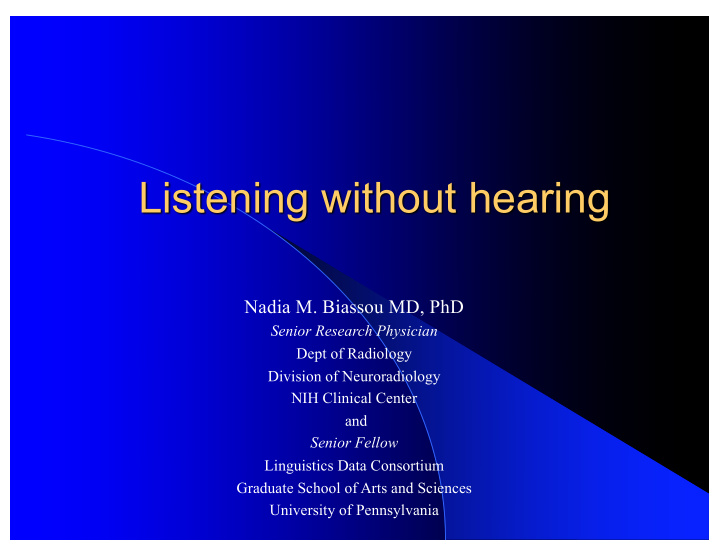



Listening without hearing Nadia M. Biassou MD, PhD Senior Research Physician Dept of Radiology Division of Neuroradiology NIH Clinical Center and Senior Fellow Linguistics Data Consortium Graduate School of Arts and Sciences University of Pennsylvania
Financial Disclosure l None
Learning Objectives l The basics of the physics of speech l What is currently known about conscious neurobiologic speech perception? l Can unconscious speech perception by reliably measured? l What can its study tell us about the general nature of speech perception and about the human brain that processes it?
Introduction l What is speech and why is it special?
Speech is the entryway to human linguistic communication
1 Pa 2. Ta 3. Ka
Formant frequency l F0 is called the fundamental frequency and represents the frequency of vocal cord oscillation
Formant frequencies l Oscillation of vocal cords and its harmonics l F0 1 l F1 3 l F2 5 l F3 7
The speech waveform l The production of any sound during word production is simultaneously influenced by the sounds that precede and follow it. l Liberman et al., 1957
Coarticulation of sounds l “ebb” vs. “egg”
The speech spectrograms: formant frequency transitions l The formant frequencies transitions reflect coarticulation
Does the brain listen to every acoustic variation during speech perception?
Bottom Up processes Bottom-up processing refers to processing sensory information as it is coming in
TASK l PART 1: Actively decided whether real and nonreal words are real words of English, half of the real and nonreal words are acoustically manipulated
STIMULI l EXPERIMENT 1 l 40 REAL WORDS l 40 NONREAL WORDS l HALF ARE l HALF ARE ACOUSTICALLY ACOUSTICALLY MANIPUALTED MANIPULATED l HALF ARE NON- l HALF ARE NON- MANIPULATED MANIPULATED
RESULTS l The brain takes 80 74msecs longer to 70 process the 60 acoustically 50 manipulated 40 realwords, even 30 though subjects could 20 not consciously 10 distinguish the word 0 types realwords nonwords
Sensory changes affect higher order language processing BLUMSTEIN and colleagues • LEXICAL DECISION TASKS IN WHICH LEXICAL ITEMS WERE MANIPULATED ACOUSTIC GAP DETECTION (I.E. VOT) below the conscious level • Sensory alteration can affect activation semantic priming and lexical access. • FARAH et al argue that words may also be stored with visual associated information.
What are the neural networks that subserve subconscious processing of speech during conditions of increased effort? l LEFT INFERIOR FRONTAL CORTEX, ANTERIOR CINGULATE AND THALAMUS POSTERIOR SUPERIOR l TEMPORAL LOBES BILATERALLY OCCIPITAL LOBES l LEFT CEREBELLUM l
PART 2: Passively listen to real and nonreal words of English, half of which had been acoustically manipulated. STIMULI- PARTS 1 & 2 ARE MATCHED IN WORD FREQUENCY, WORD LENGTH, NUMBER OF SYLLABLES, AND IMAGEABILITY l EXPERIMENT 2 l EXPERIMENT 2 l 40 REAL WORDS l 40 NONREAL WORDS l HALF ARE l HALF ARE ACOUSTICALLY ACOUSTICALLY MANIPULATED MANIPULATED l HALF ARE NOT l HALF ARE NOT MANIPULATED MANIPULATED
Are the same networks activated in conditions of less effort? l Activation in (b) posterior superior temporal lobes and anterior cingulate are sufficiently robust even for the passive presentation of subconsciously manipulated realwords. But right frontal and right parietal lobe networks are activated
BUT IS SPEECH PERCEPTION ALL BOTTOM UP?
Top Down Processes Visual Cues and Speech Perception McGuck Effect Baysan, U. (July 2017) "McGurk Effect" in F. Macpherson (ed.), The Illusions Index. Retrieved from https://www.illusionsindex.org/i/ mcgurk-effect.
McGuck Effect BBC – Horizon: Is Seeing Believing Nov 2010
TOP DOWN PROCESSES CONTEXT AND SPEECH PERCEPTION PHONEME RESTORATION (Warren & Warren 1970)
Phoneme Restoration Effect Suboptimal environment input is overridden by context of speech to hear stimuli that is in fact absent. “The State Governors met with their respective legislatures convening in the capitol city.” “The State Governors met with their respective le…latures convening in the capitol city.”
Ed Chang and colleagues Leonard et al 2016, Nature Communications, 7:13619
Top Down Processes Yanny vs Laurel Left: YANNY Right: LAUREL Middle spectrogram is a simulated ambiguous spectrogram – BUT listeners hear Yanny or Laurel
PERCEPTION is the point of contact between multisensory information: BOTTOM UP (Objective) TOP DOWN (Subjective) l Processing of l Visual Input sensory input l Context l Can affect higher l Linguistic order cognitive and phonotactics (the linguistic processes language that you such as vision and speak) can all affect semantics. the interpretation of sensory cues.
This point of contact is dynamic in time and in space l Different neural networks can process the same types of speech cues depending on the conditions under which the cues are being processed. l Neural networks involved in processing subconscious fine grain speech cues can involve the right hemisphere under passive listening (or lighter attentional load)
Attentional networks are always being recruited to varying degrees? l Even for the passive listening of speech cues.
We hear want we want to hear This doesn’t only apply to cats or dogs!
Resting State fMRI l Passive neural networks may not be fully representative of the neural networks that subserve linguistic/cognitive processes because the network dynamics change depending on the attentional load to achieve the task at hand. It is NOT solely driven by the stimulus.
CLINICAL IMPLICATIONS l Language mapping for neurosurgery should reflect natural state of language processing as closely as possible including masked stimuli
New research l Normal aging l Alzheimer’s and other neurodegenerative disorders l Autism l Is there a genetic basis for the balance between objective and subjective speech perception?
Future research l Can we develop new wearable technologies that can diagnosis changes in the processing of sensory input in the preclinical stage of disease?
l “Our imaginations are limited by the knowledge that we currently possess” • Helen Neville (IRCS Talk, University of Pennsylvania, 1995)
l THANK YOU!
Recommend
More recommend